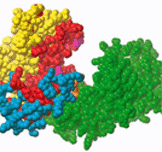Edema factor (EF) is one of three toxins that make anthrax a deadly biohazard. Researchers using the BioCars and Structural Biology Center beamlines at the Advanced Photon Source and beamlines X25 and X4 at the National Synchrotron Light Source have determined the three-dimensional structure of EF. This discovery provides important new information that may lead to the design of pharmaceuticals to counteract the effects of bacterial toxins such as anthrax. Details of the research were published in the January 24, 2002, issue of Nature.
Anthrax produces three potentially deadly toxins that can take effect even after the bacteria itself has been annihilated by antibiotics. These three toxins work together in a diabolical conspiracy against the body's immune system. The first toxin ("protective antigen") paves the way for the second toxin, "lethal factor," to enter cells. As its name implies, lethal factor then kills the cells. As the cells die, they release inflammatory agents that bring on septic shock and then death. The structure of protective antigen was published in February 1997. The structure of lethal factor was published in November of 2001.
EF is the third toxin. It causes fluid to accumulate in the lungs or other impacted parts of the body (edema means swelling caused by an abnormal or excessive accumulation of fluid). EF is doubly dangerous: It can be lethal by itself, and it also greatly increases the potency of the lethal factor toxin.
The solution to this critical third structure grew out of earlier studies of EF as a clue to a basic cellular process: how the enzyme adenylyl cyclase helps regulate cell-to-cell signaling. Under certain circumstances, adenylyl cyclase converts a common cellular energy generating-molecule, ATP, which in turn keeps under control processes such as heart rate, blood sugar level, and learning and memory. Too much cyclic ATP can make cells hyperactive; they deplete their energy and lose the ability to regulate their environment. When this happens the cells release water, bringing on edema in surrounding tissue, and then the cells die.
Researchers now know that EF is benign until it encounters a protein called calmodulin inside an infected cell. When EF and calmodulin bind, the shape of EF changes, creating a deep, narrow pocket that functions just like adenylyl cyclase, except that it is 1000 times more active and virulent. But that pocket, revealed in this study, provides a clue to halting the progress of EF. It is a perfect site for the imposition of a small molecule that can block binding.
(This text was adapted from "Structure of anthrax toxin offers clues to treatment: Third and final piece completes deadly puzzle," from the Ben May Institute for Cancer Research Web site)
Argonne is a U.S. Department of Energy laboratory operated by the University of Chicago. The Advanced Photon Source is funded by the U.S. Department of Energy, Office of Science, Office of Basic Energy Sciences.
The research reported here was supported by grants from the NIH NIGMS, NIH NIAMS, and the American Heart Association (AHA), as well as a fellowship from the AHA; by a fellowship from NIH NIDA; and partial support from the American Cancer Society.
See: "Structural basis for the activation of anthrax adenylyl cyclase exotoxin by calmodulin," by Chester L. Drum(1,2,3), Shui-Zhong Yan(1), Joel Bard(2), Yue-Quan Shen(1), Dan Lu(1), Sandriyana Soelaiman(1), Zenon Grabarek(2), Andrew Bohm(2,4), and Wei-Jen Tang(1,3), Nature 415, 396 - 402 (2002).
(1) Ben-May Institute for Cancer Research, The University of Chicago; (2) Boston Biomedical Research Institute; (3) Committee on Neurobiology, The University of Chicago; (4) Tufts University School of Medicine
Address correspondence to: [email protected] or [email protected].

